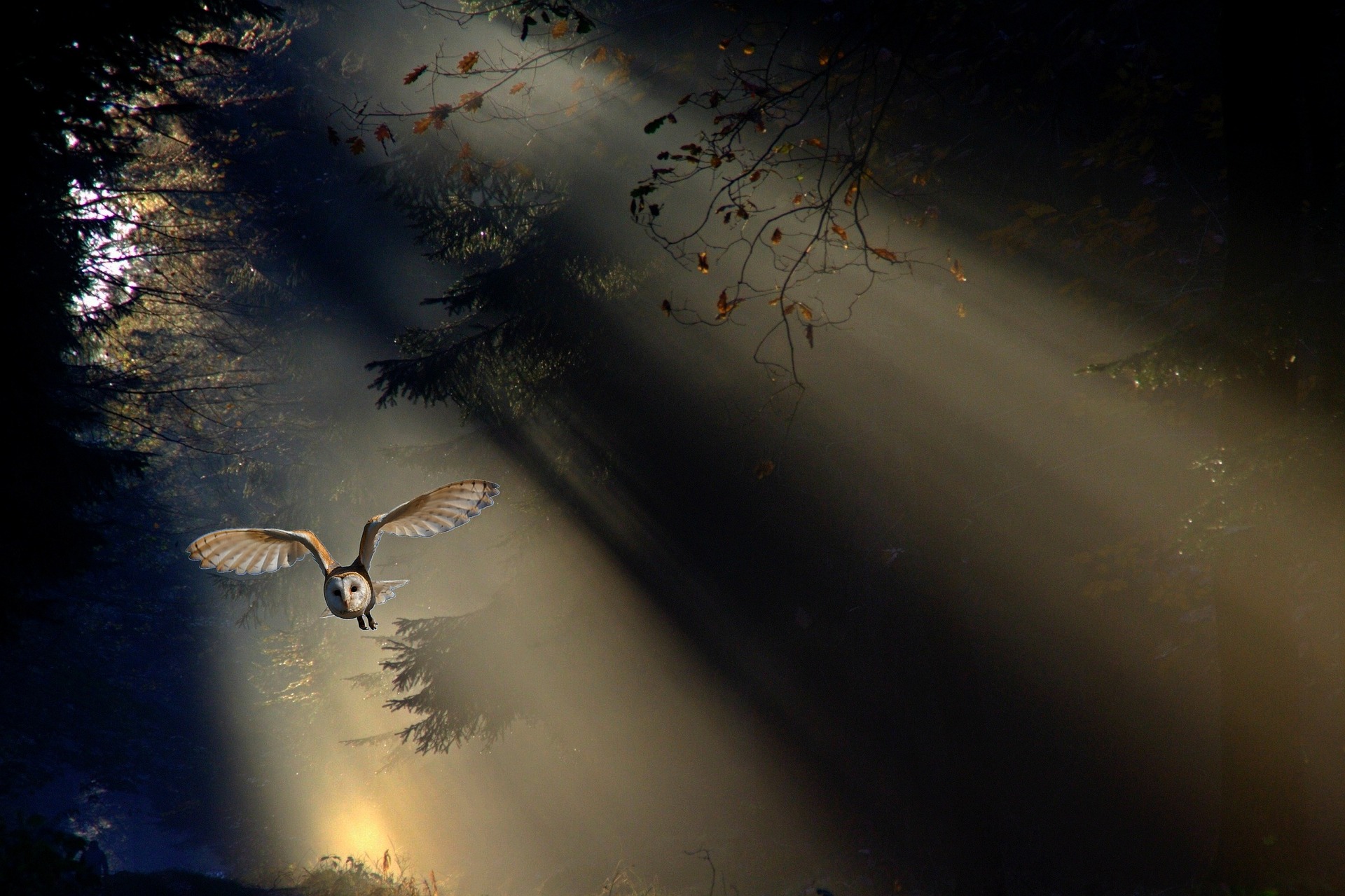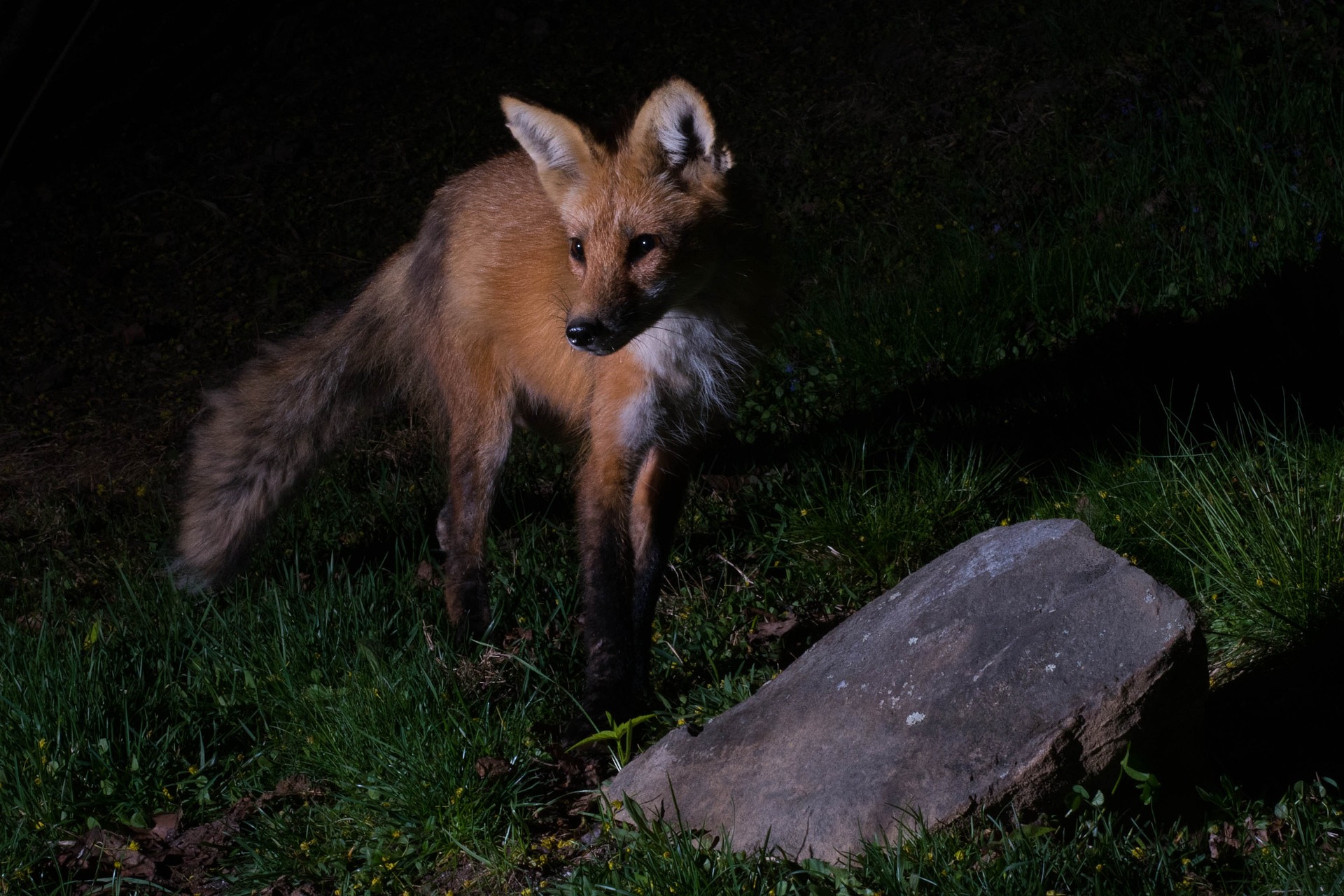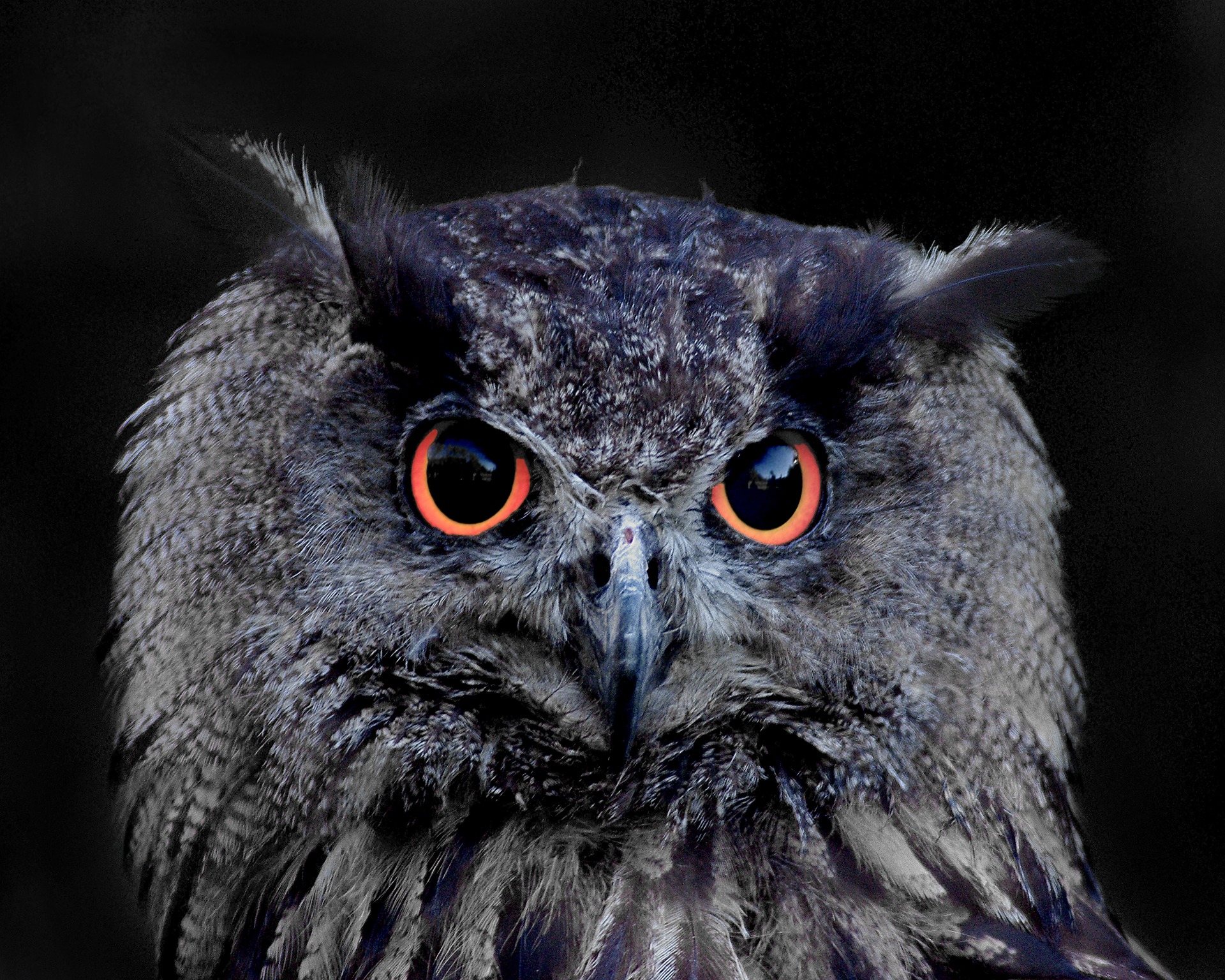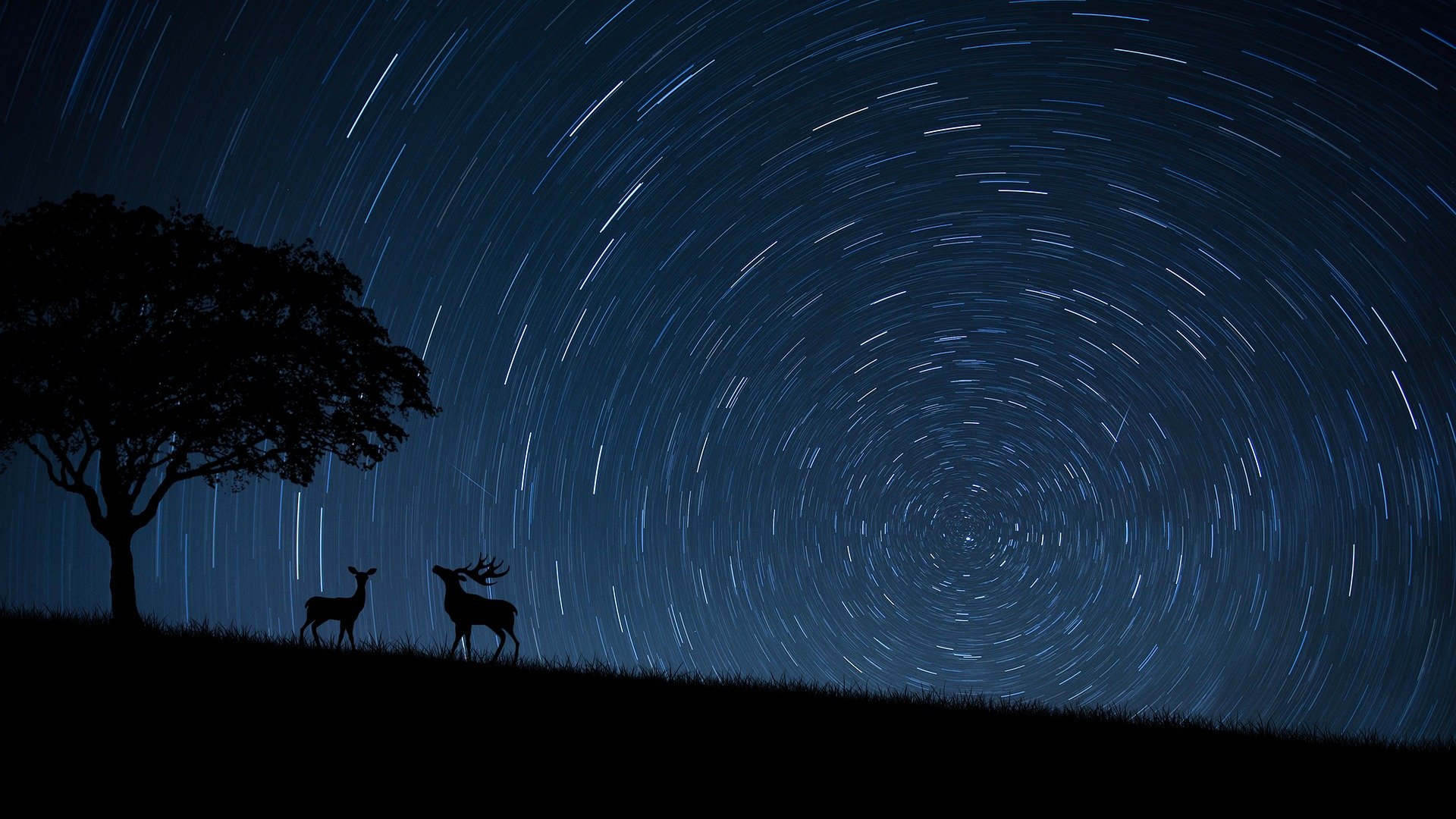Bright Side of the Night – 2.1.3
Adaptation to Nocturnal Life
Senses of Smell, Touch, Sound, Vision
The senses of animals have evolved and been refined to work best either during the day or at night. Animals that are mostly active during darkness use the visual system less than diurnal animals – those active during the day. On the other hand, nocturnal animals possess heightened acoustic senses, like owls or bats, and olfactory senses, like moths and most mammals. In general, it is essential to recognize that every animal has its own sensory bubble. While we perceive our environment as we do, other creatures smell, hear, feel, and see their environment in a completely different manner.
Ears and Echolocation
The owl’s most important sensory organ is the ear, which enables it to locate and strike prey in complete darkness. Bats use echolocation to orientate themselves in the dark and to catch insects. Echolocation relies on the emission of ultrasounds and the subsequent reading of the echo.
Highly Sensitive Eyes
The eyes of some nocturnal animals are very sensitive to light. Grass frogs, but also the medium vine hawkmoth, a moth, can even see colours in the dark. Night insects are in principle able to see colours at night as well as to navigate by means of celestial bodies.
Meanwhile, the common toad needs only a fraction of the light produced by the starry sky to catch its prey at night (0.00001 lux or lx, the unit of illuminance). To put this into perspective: the maximum brightness of the full moon is 0.3 lx.
Glowing Eyes
Many mammals tend to be nocturnal, especially smaller species. Mammals originally specialised in nocturnal life, and only some diurnal groups, such as primates, evolved colour vision. Nocturnal animals usually exhibit distinctive camouflage colours that allow them to hide from predators during the daytime resting period. Nocturnal mammals often have large pupils to take in more light, large lenses to minimize spherical aberrations and many rods (light-dark perception) in the retina, the light-sensitive layers of nerve tissue at the back of the eye. Then again, they have few cone sensory cells in the eye, limiting their colour vision. This makes e.g. diurnal squirrels and birds almost blind at night. Owls in turn, but also some mammals like the fox, deer, and wild cat, have a retro-reflective layer behind the retina. This layer leads to enhanced light sensitivity, and it is also the reason for the glow in many animals’ eyes when they are illuminated.
Light Your Fire: The Magic of Bioluminescence
Bioluminescence is the ability of living organisms to produce light by themselves or with the help of symbionts. The purpose is to ward off enemies or to attract prey and mating partners. Fireflies are probably the best-known creatures in our latitudes that glow at night. The light in their bodies is the result of a chemical reaction in which a bioluminescent substrate (Luciferin) is oxidized by an enzyme (Luciferase). In some areas, the night also exposes bioluminescent mushrooms.

Further Resources
Links below will redirect you to external websites. In accordance with the European data protection declarations, we would like to point out that by clicking on these links you may send data to external providers. We cannot prevent that.
Images


Videos
![]() Owls Have Superior Senses | Nat Geo WILD (Nature Geographic)
Owls Have Superior Senses | Nat Geo WILD (Nature Geographic)
![]() How do Bats Hunt Their Prey?| Top Bat | BBC Earth (BBC)
How do Bats Hunt Their Prey?| Top Bat | BBC Earth (BBC)
![]() Firefly Experience – Summer Night with Fireflies (Lightning Bugs) (Radim Schreiber)
Firefly Experience – Summer Night with Fireflies (Lightning Bugs) (Radim Schreiber)
![]() Dokumentary Film: The Eagle Owl: The Lord of the Night. (New Atlantis Full Documentaries)
Dokumentary Film: The Eagle Owl: The Lord of the Night. (New Atlantis Full Documentaries)
 BIOLUMINESCENZA: QUALI ORGANISMI SONO IN GRADO DI EMETTERE LUCE E A COSA SERVE? (Sub H2O)
BIOLUMINESCENZA: QUALI ORGANISMI SONO IN GRADO DI EMETTERE LUCE E A COSA SERVE? (Sub H2O)
 i pipistrelli (Superquark)
i pipistrelli (Superquark)
 a tu per tu con il gufo comune (Gufotube)
a tu per tu con il gufo comune (Gufotube)
Online Resources
![]()
 The influence of light pollution on plants, animals and ecosystems (Helle Not)
The influence of light pollution on plants, animals and ecosystems (Helle Not)
![]()
 Verlust der Nacht / Loss of the Night: Interdisciplinary Research network
Verlust der Nacht / Loss of the Night: Interdisciplinary Research network
 Notturno Vs Diurno: Qual È La Differenza? (Worldsanimal)
Notturno Vs Diurno: Qual È La Differenza? (Worldsanimal)
 Ecolocalizzazione (National Geographic)
Ecolocalizzazione (National Geographic)
 I “ghiri ciechi” sono la prima specie di roditori a poter “vedere” con le orecchie (National Geographic)
I “ghiri ciechi” sono la prima specie di roditori a poter “vedere” con le orecchie (National Geographic)
 Come funziona il sonar dei pipistrelli? L’ecolocalizzazione è una questione di udito! (Geopop)
Come funziona il sonar dei pipistrelli? L’ecolocalizzazione è una questione di udito! (Geopop)
 Cogli la notte: svelato il mistero della visione dei mammiferi notturni (CORDIS)
Cogli la notte: svelato il mistero della visione dei mammiferi notturni (CORDIS)
 Occhi imbattibili al buio per i predatori della notte (rivistanatura)
Occhi imbattibili al buio per i predatori della notte (rivistanatura)
 Cos’è la bioluminescenza (Geopop)
Cos’è la bioluminescenza (Geopop)
Further Readings
![]()
 Regularly updated Literature and links with regards to light pollution and dark skies (Helle Not)
Regularly updated Literature and links with regards to light pollution and dark skies (Helle Not)
![]()
 Literature & Links on the website “Verlust der Nacht/Loss of the Night”
Literature & Links on the website “Verlust der Nacht/Loss of the Night”
![]() Scientific paper on “Scotopic colour vision in nocturnal hawkmoths” (2002)
Scientific paper on “Scotopic colour vision in nocturnal hawkmoths” (2002)
 Publikation: Lichtverschmutzung und die Vulnerabilität nachtaktiver Insekten (2019)
Publikation: Lichtverschmutzung und die Vulnerabilität nachtaktiver Insekten (2019)
 Batteri bioluminescenti (Zanichelli)
Batteri bioluminescenti (Zanichelli)
 La bioluminescenza delle lucciole: dalla chimica delle notti d’estate a possibili applicazioni tecnologiche (Arianna Gentilin)
La bioluminescenza delle lucciole: dalla chimica delle notti d’estate a possibili applicazioni tecnologiche (Arianna Gentilin)
Teaching Material
![]() Bat detectors convert bat calls to make them audible to human ears (Bat Conservation Trust)
Bat detectors convert bat calls to make them audible to human ears (Bat Conservation Trust)
 Animali diurni e notturni (Giunti scuola)
Animali diurni e notturni (Giunti scuola)
 Gli organi di senso degli altri animali (Zanichelli)
Gli organi di senso degli altri animali (Zanichelli)
 I sensi degli animali (Parco zoo Punta Verde)
I sensi degli animali (Parco zoo Punta Verde)
 Bioluminescenza marina e oltre… (Scuola di didattica della Chimica “Del Re”)
Bioluminescenza marina e oltre… (Scuola di didattica della Chimica “Del Re”)
For Kids
![]()
 Materials for young scientists: Quiz, Arts and craft corner, App and Exhibition for schools. (Loss of the Night network)
Materials for young scientists: Quiz, Arts and craft corner, App and Exhibition for schools. (Loss of the Night network)
![]() “The Bat Moth Game” (Bat Conservation Ireland)
“The Bat Moth Game” (Bat Conservation Ireland)
 Unterrichtsmaterialien für Schulen – “Tierprofi Wildtiere” (Die Umweltberatung)
Unterrichtsmaterialien für Schulen – “Tierprofi Wildtiere” (Die Umweltberatung)
 Unterrichtsmaterialien für Schulen – “Lichtverschmutzung” (Die Umweltberatung)
Unterrichtsmaterialien für Schulen – “Lichtverschmutzung” (Die Umweltberatung)
 Wissens- und Methodenbox „Kunstlicht, Nacht und Sternenhimmel“ (Naturfreunde)
Wissens- und Methodenbox „Kunstlicht, Nacht und Sternenhimmel“ (Naturfreunde)
 Animali diurni e notturni (Maestra Silvia video)
Animali diurni e notturni (Maestra Silvia video)
 I sensi degli animali: quasi superpoteri (Uomo in erba video)
I sensi degli animali: quasi superpoteri (Uomo in erba video)

